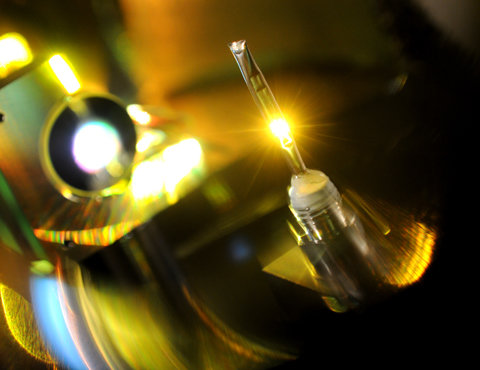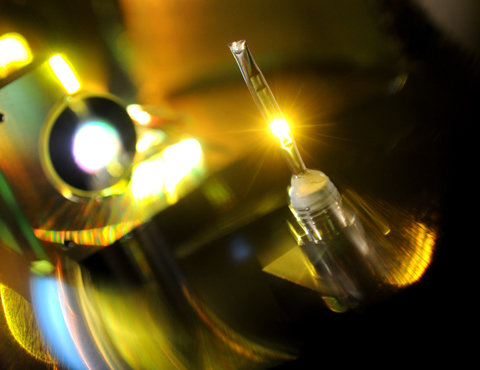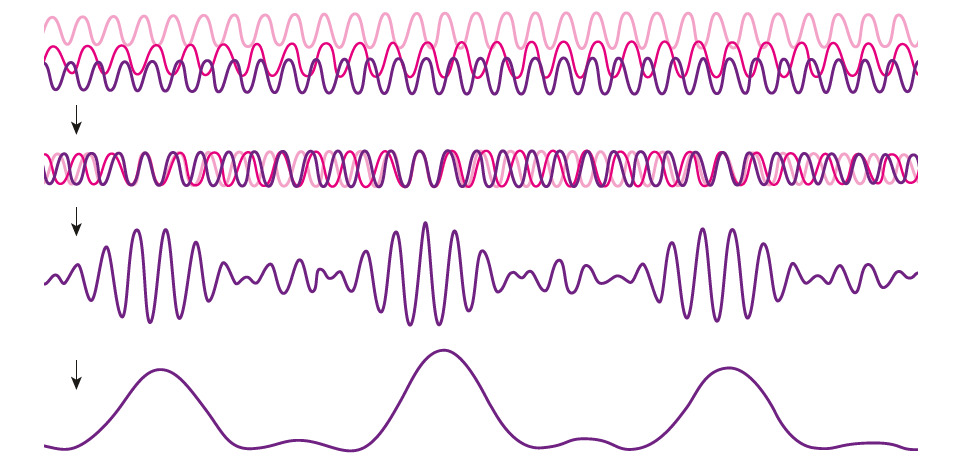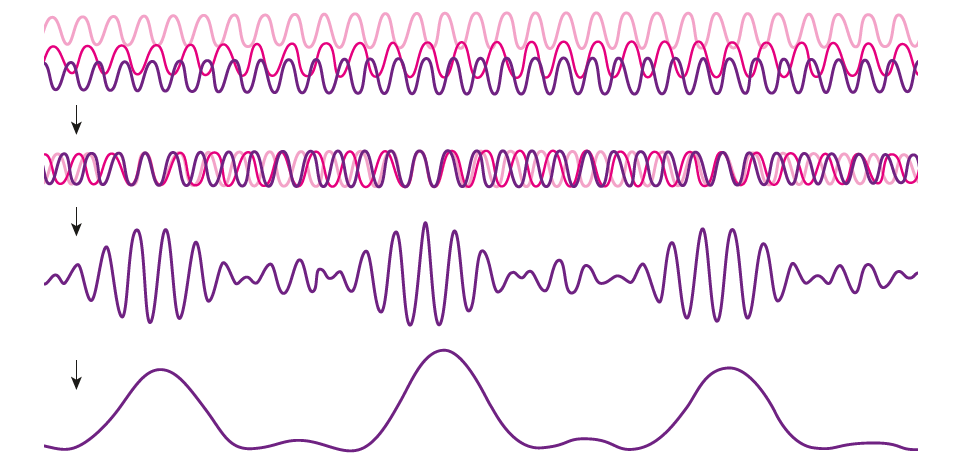Nobel Prize: Flashes of Light Catch Electrons in the Act
5 October 2023: We have replaced our initial one-paragraph announcement with a full-length Focus story.
The Nobel Prize in Physics this year honors the pioneering work of physicists who succeeded in making extremely fast light pulses for probing electron behavior. The award is shared equally by Pierre Agostini from Ohio State University, Ferenc Krausz from the Max Planck Institute of Quantum Optics in Germany, and Anne L’Huillier from Lund University in Sweden.
L’Huillier’s research helped set the stage for attosecond (10−18 s) science by demonstrating a laser-based method of generating a set of high-energy “harmonics”—light waves whose frequencies are multiples of the input laser frequency. Later work by Agostini and Krausz showed that attosecond pulses arise from the combination of many of these harmonics. Armed with these impossibly short light flashes, physicists have been able to capture the motion of electrons as they zoom across an atom or barrel through a material. Attosecond science offers a wealth of applications, such as probing chemical reactions and making ultrafast switches.
A train of laser pulses is like a microscopic strobe light that can isolate the motion of an object at a specific time. Researchers have long used femtosecond (10−15 s) pulses to capture the motion of atoms in chemical reactions (see 1999 Nobel Prize in Chemistry). Creating these pulses typically requires combining waves with a wide frequency range, or bandwidth, and letting them interfere so that their energy is concentrated into a small window of time. Squeezing this window to the attosecond timescale would allow electron motion to be tracked, but “you need so much more bandwidth for attosecond pulses than you do for femtosecond ones,” says Mette Gaarde from Louisiana State University.
That large bandwidth appeared, like a gift, in the 1980s with the observation of high-harmonic generation. When a high-powered laser is fired into a gas of atoms, the outgoing light is a mix of different waves, all having frequencies that are multiples of the laser frequency. The appearance of such harmonics is common (like when a guitar string is plucked), but the laser-produced harmonics are surprising in that the waves, or modes, do not die down as the frequency increases. Instead, the harmonic spectrum shows a plateau of constant intensity that extends over several tens of harmonic modes before reaching a cutoff in the extreme ultraviolet (UV) range. “The plateau was completely unexpected,” says Maciej Lewenstein from the Institute of Photonic Sciences in Spain. Understanding this large-bandwidth plateau and other features of high-harmonic generation was a key step to realizing attosecond pulses.
Building on previous models [1, 2], L’Huillier, Lewenstein, and their colleagues provided a full quantum model of high-harmonic generation in 1994 [3]. The basic picture is a three-step process that starts with the intense laser field distorting the electric-field structure within the atom, which allows an electron to tunnel out. This liberated electron is then accelerated to high energy by the laser field. And finally, the electron is recaptured by the atom and “gives away all the energy that it gained on the way,” Lewenstein says. That released energy appears in the form of the harmonic modes. L’Huillier and Lewenstein’s model showed how that light depends on the quantized trajectories of the liberated electrons.
One immediate question was whether the harmonic modes could interfere with each other and thus produce attosecond pulses. Interference requires a kind of synchronization, or coherence, between the emission of different atoms. “If the atoms do not collaborate with one another, then the outgoing signal will be a chaotic mix,” Lewenstein says. In 1996, he and L’Huillier worked together again to show theoretically that the atoms emit “phase-matched” light, which leads to coordination of their output [4]. Subsequent experiments explored this coherence; in particular, L’Huillier’s team, which included Gaarde as a PhD student, showed that the coherent behavior in individual harmonics could last for tens of femtoseconds [5].
At the end of the 1990s, all signs pointed to attosecond pulses being present in high-harmonic-generated light, but actually detecting these extreme UV pulses posed a problem. Most pulse-characterization techniques at the time were not suited for these high frequencies—glass and other optical equipment rapidly absorb UV light. “We knew that there were attosecond pulse trains, but to show that experimentally required an ingenious idea,” Lewenstein says. This is where the work of Agostini and Krausz came in.
Agostini and his colleagues devised a technique, called RABBIT, that focuses the high-harmonic light into a gas target, where it combines with light from the initial driving laser. The atoms in the gas respond to the injected light by ejecting electrons, which the researchers could detect. The arrival times of the electrons showed that the team’s high-harmonic light consisted of a train of 250-attosecond pulses [6]. Krausz and co-workers developed a different strategy in which they tuned their system so that only a single pulse was created in their high-harmonic-generation process. Using a pulse-measuring technique called streaking, they confirmed the presence of 650-attosecond pulses in their experiment [7].
Once attosecond pulses were definitively measured, it was time to put them to use. One of the first applications was the study of the photoelectric effect—the production of free electrons when a material is exposed to light of sufficiently high frequency. With attosecond pulses, researchers could precisely time how long it takes to liberate an electron from a material (see Focus: Photons Team Up). Further developments allowed attosecond researchers to track electrons as they migrate around an atom or molecule during chemical reactions (see Viewpoint: Electrons Filming Themselves). “We have made a few of these attosecond ‘electron movies,’ and there will be a lot more over the next five to ten years,” Gaarde says. She’s also excited about an emerging frontier where solid materials are probed with attosecond pulses—perhaps leading to future pulse-based control of material properties.
L’Huillier is just the fifth woman to win the Nobel Prize in Physics. “She is a wonderful role model,” Gaarde says. “All of [the 2023 laureates] are fantastic physicists, and it's very beautiful for the whole field of attosecond science,” says Lewenstein.
–Michael Schirber
Michael Schirber is a Corresponding Editor for Physics Magazine based in Lyon, France.
References
- K. C. Kulander et al., “Dynamics of short-pulse excitation, ionization and harmonic conversion,” Super-Intense Laser-Atom Physics 95 (1993), in B. Piraux et al., eds., Super-Intense Laser-Atom Physics, NATO ASI Series, vol. 316 (Springer, Boston, MA).
- P. B. Corkum, “Plasma perspective on strong field multiphoton ionization,” Phys. Rev. Lett. 71, 1994 (1993).
- M. Lewenstein et al., “Theory of high-harmonic generation by low-frequency laser fields,” Phys. Rev. A 49, 2117 (1994).
- P. Antoine et al., “Attosecond pulse trains using high–order harmonics,” Phys. Rev. Lett. 77, 1234 (1996).
- M. Bellini et al., “Temporal coherence of ultrashort high-order harmonic pulses,” Phys. Rev. Lett. 81, 297 (1998).
- P. M. Paul et al., “Observation of a train of attosecond pulses from high harmonic generation,” Science 292, 1689 (2001).
- M. Hentschel et al., “Attosecond metrology,” Nature 414, 509 (2001).







